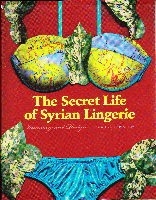
Secret Life of Syrian Lingerie: Intimacy and Design
By Malu Halasa and Rana Salam
It would be easy to mistake this book for a catalog. It is roughly the size of a glossy annual displaying carefully arranged Swedish furniture. It is a bendy paperback that carries a faint scent of plastic-coating. And several of its pages bear poorly-lit, sweetly-smiling women modeling underwear.
But the volume is more coffee-table book than anything, with sturdy glossy pages, that compiles within its soft covers (both depicting, beneath a fairly demure book jacket, a woman with a slightly plump and pierced belly, wearing fringe-bedecked hat and string bikini bra and panties) a broad but brief essay on evolving Syrian mores and manufacturing, the diary of a frustrated filmmaker seeking out women willing to talk about their intimate apparel, a Q&A with a male fundamentalist-turned-modernist, and a collection of self-portraits and poetry by Iman Ibrahim.
The written segments – sometimes on pages covered in pink-and-black lace – provide quick and necessary context. One piece explains Syria’s long and well-known history of authoritarian rule and strict morality, which is slipping as Damascus replaces the troubled Beirut as the sex capital of the Middle East. The essays also provide lesser-known factoids about the country’s manufacturing sector, which has earned the country the nickname “the China of the Middle East,” but which only began making bras in the 1970s, selling them primarily in a segment of a Damascus bazaar. Interviews with and quotes from lingerie shopboys and their clients, reveal the role of lingerie broadly – to foreshadow pleasure, to teasingly initiate imagined moments, to be at once liberating and restraining of mind and flesh – and more particularly for Syrians.
Halasa and Salam suggest that a conservative culture in which, for some women, ordinary clothing is actually underwear, lingerie becomes extreme. The Syrian style seems hilarious and strangely inventive, answering every possibly fantasy but maintaining a sense of humor mostly absent from American underwear. The samples the authors have included are constructed from lace and latex, plastic and burlap, in shapes that sometimes seem to bear no relation to the contours of the female form. Many are feathered, decorated with fabric flowers or beads, like a grade-school-girl’s (or an inexperienced man’s) fantasy of grown-up underwear. Some are frankly erotic – with “grab holes” or zippers, edible parts and written directions – and others are bizarre, festooned with fake cell phones, day-glo plastic scorpions, or buttons that play songs when pushed (think nursery school sing-alongs, not Barry White). The book, like the best lingerie, reveals, without exposing or exploiting.
Excerpt: “When [lingerie designer Shadi Siofi] states that the inspiration for his designs comes from God, his boss contravenes: ‘God has no interest in lingerie.’ He then adds that they look at French magazines like Cherie and at U.S. brands like Victoria’s Secret.”
Further reading: Creating Spaces of Freedom, The Corset: A Cultural History
.




Send A Letter To the Editors